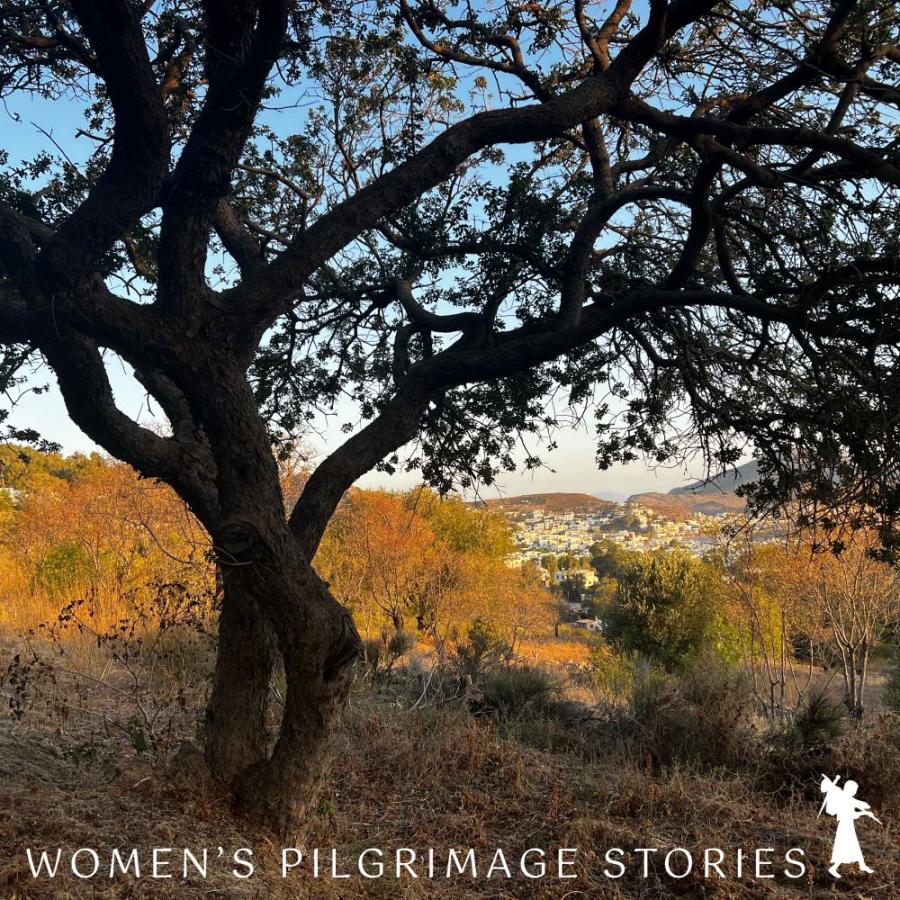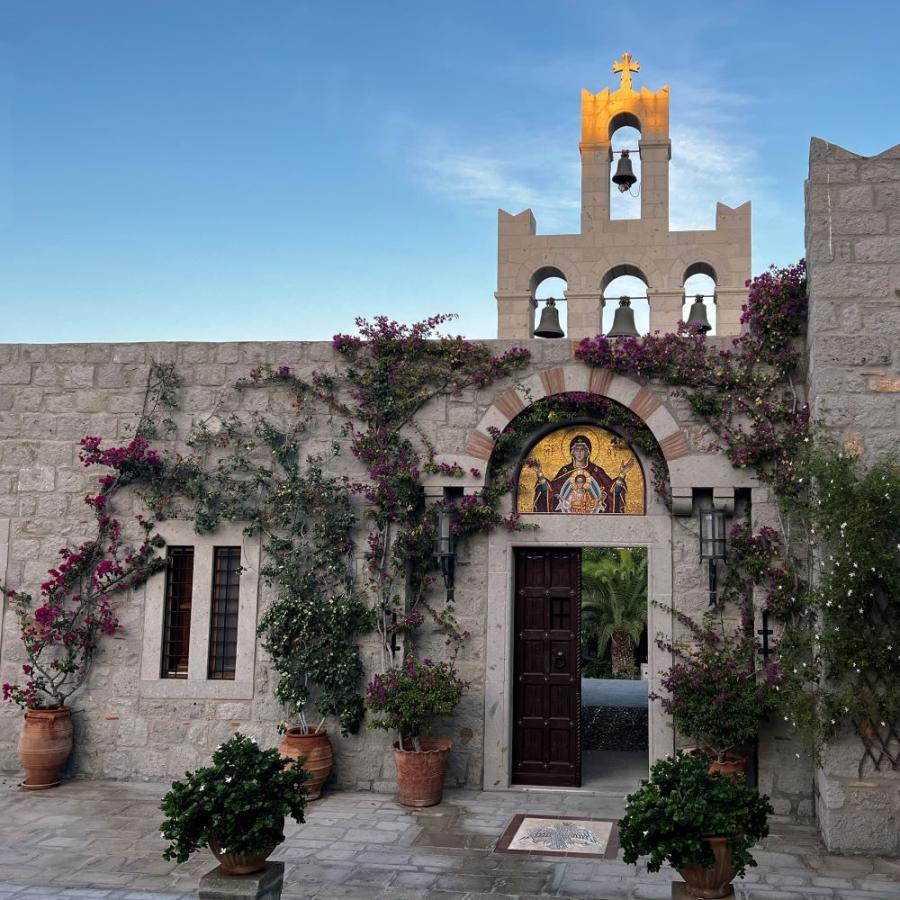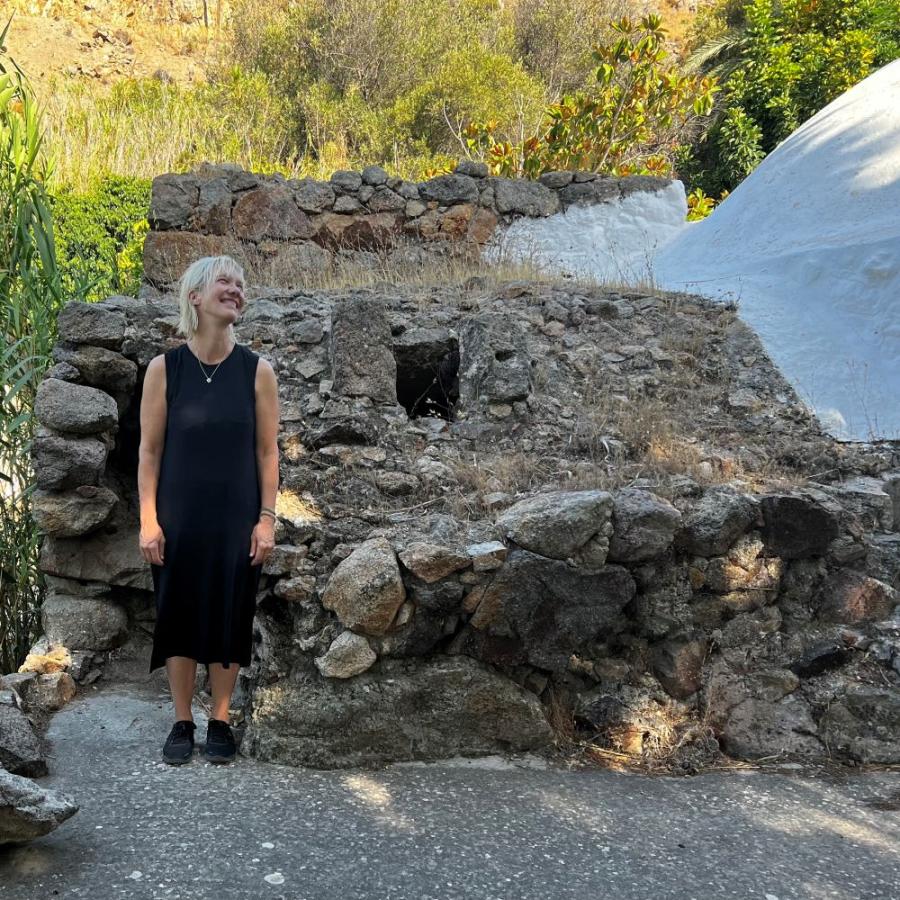
My pilgrimage to Patmos Island in Greece last fall really began on an earlier pilgrimage five years ago to England, sitting with Metropolitan Kallistos, who told our small group that “to 'pray without ceasing' is not something we should try to do as often as possible, but is something that we potentially 'are' ... to become a person who has been turned into prayer!”
Through a series of 'serendipitous' events, I have been given the honor to help continue the work of pilgrimage and prayer that the late Metropolitan Kallistos supported for years on Patmos, where he was a monk and the spiritual child of Saint Amphilochios (glorified in 2018)- an early pioneer of ecological spiritual life and lover of trees. (If you attended the Axia pilgrimage panel discussion, you may remember that I spoke about Patmos and Essex.)
After spending a contemplative week at the Essex monastery, soaking up hours and hours of communal Jesus Prayers in a quiet, candlelit chapel with many-winged seraphim icons hovering overhead, the Greek adventure began. My traveling companion and I leapt onto an exhilarating nighttime ferry, charging through the Aegean sea toward our destination. We emerged from our tiny bunk room and descended onto Patmos Island, home of Saint John the Beloved, at 3 am.
We made our way to the 'Gardens of Discovery Ecological Centre', where my host had preparations planned for my own personal pilgrimage and initiation into the hidden secrets of sacred sites sprinkled throughout the island. Some of the first friends I met were Icarus and Apollonius, a pair of small skyrian horses (an endangered species), who kindly greet visitors, connecting them to creation in their charming, furry way. They live just beyond the local stonecrafted eco-lodges overlooking the Aegean sunset. There, educational programs are held, and a resource library dedicated to Metropolitan Kallistos is being established. One of my future tasks here will be to help develop a new-world scriptorium, offering instruction in handmade paper with olive leaf inclusions, letterpress printed scripture cards, and artisanal parchment for handbound books, such as the Gospel of Saint John.
The next morning I awoke to the braying of nearby donkeys. Soon, I was whisked off for a challenging climb up Petra Rock, my hands and feet gripping the red hewn stairway carefully until we reached the rounded summit. There we looked out on the crystal clear water into which we would soon dive for a refreshing swim, before enjoying a beach picnic with succulent local fare and British tea. Hermits made their homes in the crevices of this massive archeological treasure for centuries, carving out cisterns and caves for sacred ceremonies as they remained safe from pirates. I imagined how dark the nights might have been in these shallow caves, and how the cave dwellers may have helped one another survive in those early Christian hermitage communities, carved into Petra Rock.
Ancient stone paths called monopatis criss-cross the island, and provide a delightful seven-minute walk either up to the men's Monastery of Saint John the Theologian, or down to the women's Monastery of Evangelismos. There we celebrated their feast day, among many priests, parishioners and pilgrims ... a joyous occasion! Walking to holy liturgies like these gave me an intimate sense of 'the village' everybody wants to return to. On Patmos it feels easy, and so beautiful to be a part of this centuries-old culture.
My host introduced me to many small churches and sanctuaries tucked into hidden alcoves and suspended from cliffs around the island, often swimming in the warm sea before returning to our cozy lodgings. Liturgy at the Cave of the Apocalypse was a wild and holy experience, where we stood with our heels resting higher than our toes as the stone cave floor curved upward. We were right next to the sacred notched rock where Saint John used to place his hand, and rest the scroll of the book of Revelation while it was in progress. Three rocks connect overhead, representing the trinity, whose fissures conveyed the voice of God to Saint John, as he dictated the book of Revelation to his assistant, Prochorus. A corner is cordoned off where a young boy once experienced a vision of the saint resting there. At one point in the service, the Greek woman delivering the prosphora couldn't open the package, so the old priest (who looked like I would imagine Saint John himself) suddenly grabbed a knife, and with a single dramatic slice, opened it up wide, then scurried the holy bread back into his small stone altar to prepare for holy communion. These kinds of pilgrimage memories are unforgettable, transcending the world as we know it, and transporting us to another place and time.
I was given a deeply moving task in the garden of Saint John, adjacent to his cave. Walking up and down the tiered olive groves that belong to the Gardens of Discovery Centre, my job was to choose an olive tree as 'my own', and to care for this new friend by attentively pruning its branches. I began slowly, then found myself high in the treetop, finally descending with a new sense of connection to this created world, and to the saints who honored the trees on this holy island. Saint Amphilochios was well known as a great proponent for the planting, watering and care for the trees as tasks crucial to the well-being of the island and the hearts of those tending them. He often prescribed the planting of trees as an act of penance after confession, which blossomed into a great greening of the island. Patriarch Bartholomew (described as the 'green patriarch' by Al Gore) often champions Patmos and Saint Amphilochios in his talks, and has warmly endorsed the Gardens of Discovery Ecological Centre, where pilgrims can share the experience of caring for the trees in the garden of Saint John, or gather herbs for their meal in the garden of the holy of holies, which surrounds the Centre.
The last night on Patmos we enjoyed a delicious Mediterranean dinner in Chora, at the top of the world, overlooking the island and sea next to the monastery of Saint John the Theologian. We brought with us rich memories of our illuminated afternoon spent in the flowered archways beside the stone chapel, the lively museum, and the important ancient library of the storied 11th century castle-like structure crowning the island. This holy monastery and UNESCO world heritage site was founded by Saint Christodoulos in 1088, and continues to house a men's monastic community, to which Metropolitan Kallistos belonged as a brother.
In his openhearted way, Metropolitan Kallistos continues to teach us gratitude as we connect with the rare and holy places we may encounter on pilgrimage, with his words:
'If I do not feel a sense of joy in God's creation, if I forget to offer the world back to God with thankfulness, I have not yet learnt to be truly human.'


Jennifer Anna Rich lives on a small farm near Portland, Oregon. She is co-owner of oblation papers & press, author of Prayer Spa: Ancient Treatments for the Modern Soul, and soon to be released by Ancient Faith, The Little Way of a Pilgrim. She holds a Master’s degree in theology, and is a board member of Beauty First Films, whose recent debut, 'Amphilochios: Saint of Patmos' is screening now. She was honored as an Axia woman of the week, and is helping to establish the 'Gardens of Discovery Ecological Centre' on Patmos Island, dedicated to Metropolitan Kallistos Ware, who was an avid supporter of the project.
=


